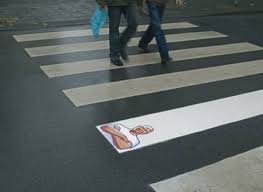
In the depression era of much earlier times it was someone wearing a sandwich board that walked up and down the city streets advertising anything from a movie to a fast food establishment, but today’s promoters go a lot further to get recognition.
This kind of activity is called “Guerrilla Marketing” – a name that indicates the element of surprise that characterizes a wide variety of promotions. It can include a costumed mascot showing up at a news conference or a skydiver dropping into a football match with a logo on his parachute. And of course it gets lots of attention.
Jay Conrad Levinson is hailed as the “father of guerrilla marketing”. In his book Guerrilla Marketing for The 21st Century, he describes guerrilla marketing this way:
“I’m referring to the soul and essence of guerrilla marketing which remain as always — achieving conventional goals, such as profits and joy, with unconventional methods, such as investing energy instead of money. I’m also referring to humanity which is relatively unchanged since the first book, indeed, since the first human.”
As Levinson points out, guerrilla marketing techniques have few limitations. Jim Valovic of Gloversville, N.Y. concocted a deliberately controversial event that earned Van’s Harley-Davidson a tremendous amount of publicity.
Van’s advertisement for a “Cat Shoot” to be held at the store on June 1, brought calls from the media, Humane Society, SPCA, local police chief and even the Mayor, wanting to know what was going on. To all callers, Jim replied “show up on the first and find out.”
The media jumped on it. Van’s was on front pages of three major newspapers (“Cat Shoot for real or hoax?” was one of the headlines). What everyone saw on the day of the event was a six-foot high cartoon cat that they could shoot- with a paint ball gun at three shots for a dollar. Signs announced that all proceeds would go to the Humane Society.
Reporters and crews from press, radio and TV showed up in response to Jim’s invitation and Van’s got even more coverage.
Guerrilla marketing doesn’t always generate positive outcomes. Remember the streaker craze of the late 1970s and early 1980s? It seemed to have been resurrected at a major sporting event in Sydney, Australia last year. Two men adorned with a telecom’s corporate logo (and that was all they were wearing) did a ‘streak’ across the field in full view of 80,000 spectators and millions of TV viewers.
Naturally, the two streakers were arrested. When it came out that the whole thing was a publicity stunt the public outrage backfired on the telecom and the CEO was forced to publicly apologize.
Retail advertisers are by far the biggest users of guerrilla marketing. They use it to make a special offer, not as a branding exercise. As the cost of advertising signage gets more expensive and attracts increasing restrictions, particularly in metropolitan areas, guerrilla marketing using human signs offers an inexpensive alternative.
It’s also a lot cheaper than paying for advertising in a metropolitan newspaper. The cost of hiring a costume and somebody to wear it is a small fraction of the cost of placing a display advertisement.
On the negative side, most human signs ply their trade on public property in violation of local legislation. The cities in Collin County, Texas are a good example of how authorities feel about this aspect of guerrilla marketing.
The sign ordinance in the city of Frisco is 60 pages long. The ordinance includes the following definition:
“A human sign is a sign held by or attached to a human for the purposes of advertising or otherwise drawing attention to an individual, business, commodity, service, activity, or product. A person dressed in costume for the purpose of advertising or otherwise drawing attention to an individual, business, commodity, service, activity, or product shall also be construed as a human sign.”
Frisco’s ordinance allows human signs only on private property. Citations for sign violations in Frisco are a misdemeanor with a maximum fine of $500 each day for each separate offence.
In the city of Plano human signs are allowed only on shopping center property. Inspectors can issue citations with fines costing from $500 to $2,000 per offence. And in the city of Allen human signs are illegal – anywhere.
Not that this in any way deters Jay Conrad Levinson who steadfastly declares: “Guerrilla marketing is needed because it gives small businesses a delightfully unfair advantage: certainty in an uncertain world, economy in a high-priced world, simplicity in a complicated world, marketing awareness in a clueless world.”
Copyright 2003, RAN ONE Inc. All rights reserved. Reprinted with permission from www.ranone.com.

 Chris’ combination of academic credentials, career experience and temperament ideally suit his calling as a business development advisor. Clients say he has a mind for business and a heart for service.
Chris’ combination of academic credentials, career experience and temperament ideally suit his calling as a business development advisor. Clients say he has a mind for business and a heart for service.